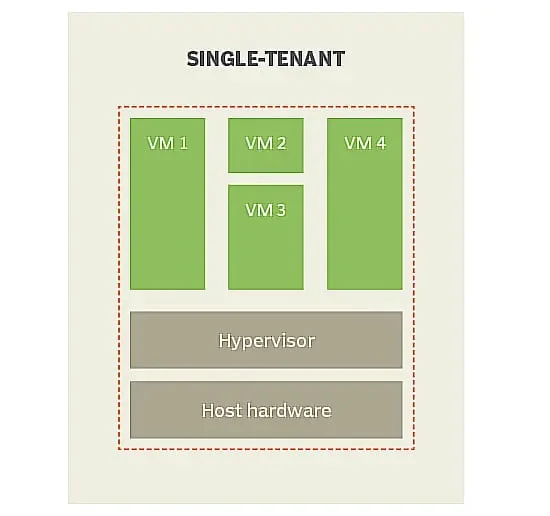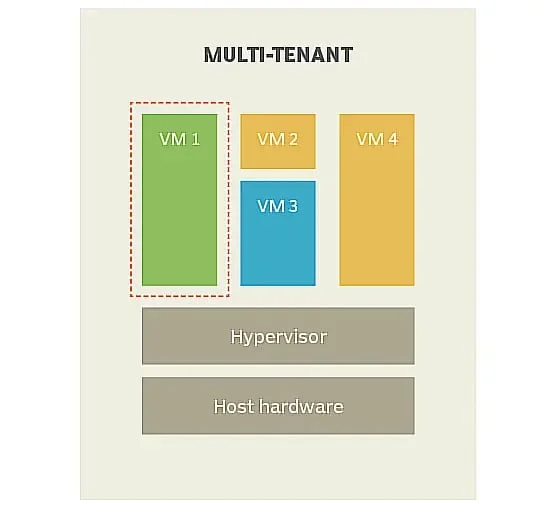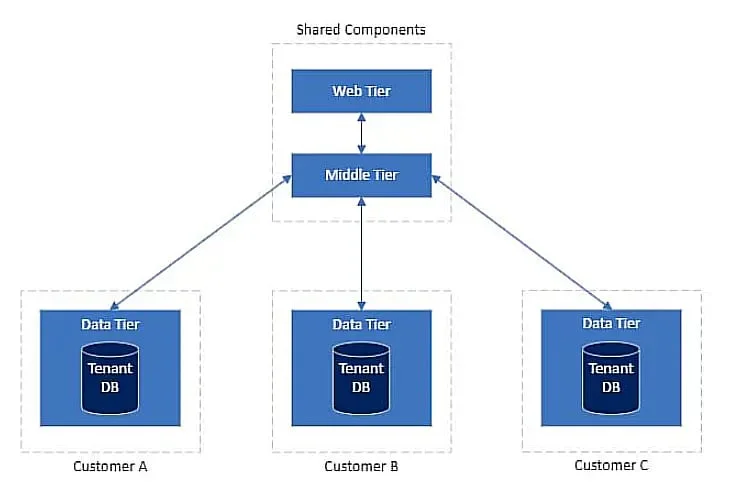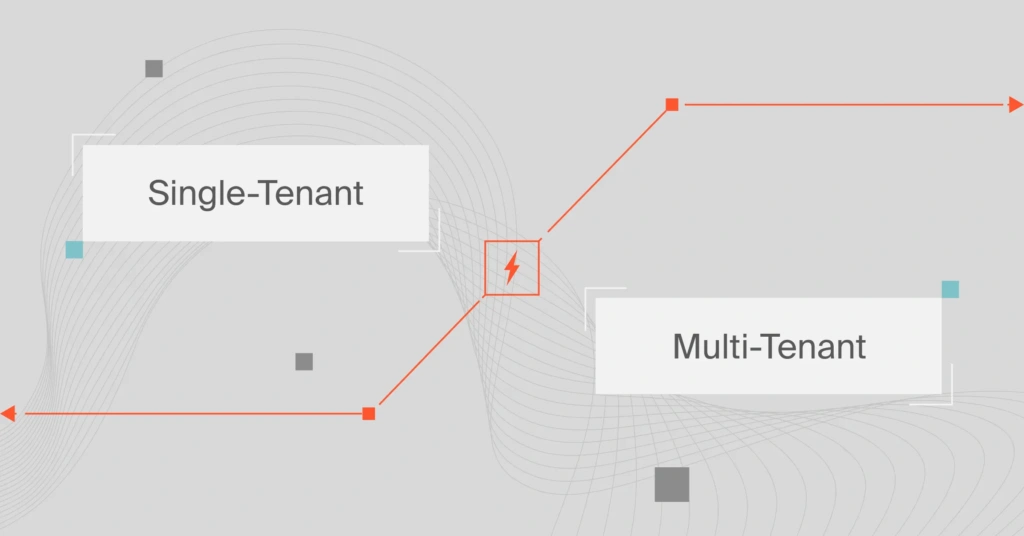When operating in the cloud, one of the key decisions to make is about which type of architecture to adopt for your business and customer data. This is because choosing cost-effective architecture is key to building profitable SaaS software.
Single-tenant and multi-tenant cloud environments are the options to consider. Both types of architecture have security and privacy implications. There’s also the issue of cost, which differs significantly depending on the architecting model you adopt.
In this article, we’ll compare multi-tenant vs. single-tenant cloud architecture and how to build more cost-effective applications irrespective of the model you operate.
Table Of Contents
- What Is Single-Tenant Cloud Architecture?
- What Is Multi-Tenant Cloud Architecture?
- What Is A Mixed Tenancy Model?
- Single-Tenant Vs. Multi-Tenant Architecture
- Single-Tenant Benefits And Drawbacks
- Multi-Tenant Benefits And Drawbacks
- When To Use Each
- Understanding Cost Per Customer In Multi-Tenant Architecture
- Frequently Asked Questions About Single-tenancy Vs. Multi-tenancy Architectures
What Is Single-Tenant Cloud Architecture?
In SaaS, a single-tenant architecture is where a single instance of the software application, and its supporting infrastructure, serves a single customer (tenant).
The single instance of the software runs on a dedicated cloud server for just this one customer. So there is no sharing it with any other customer of the SaaS provider.

Credit: TechTarget – In a single tenancy model, all the VMs are dedicated to a single customer’s usage. The SaaS provider manages the infrastructure (hypervisor and host hardware).
Single tenancy in cloud computing also means:
- The hosting vendor manages some aspects of the dedicated infrastructure and the software instance.
- The customer retains most of the control over how to customize the software and infrastructure.
- Because the infrastructure and software instance is not shared, single tenancy often provides greater confidentiality, security, backup, and performance than shared infrastructure.
- Each tenant has their own isolated environment, giving them greater flexibility than shared infrastructure models.
- The dedicated service costs more than a shared architecture
What Is Multi-Tenant Cloud Architecture?
A multi-tenant architecture is where a single software instance and its supporting infrastructure are shared among two or more customers (tenants) at the same time.
While each tenant’s data is isolated from the other tenants’, each customer shares a single database, software application, and SaaS server with the others.

Credit: TechTarget – In a multi-tenancy model, a customer uses just one instance out of several. The SaaS provider controls the underlying infrastructure.
Multi-tenancy in cloud computing means that:
- All customers are physically integrated but logically separated.
- All tenants share the same codebase and database.
- A single instance of the SaaS application runs on a single server and serves multiple customers at the same time.
- Each tenant can customize their database schemas, UI colors, and application rules to some extent. But the hosting provider yields the most control over the SaaS infrastructure.
- Multi-tenancy leverages economies of scale to lower operational costs compared to a dedicated environment.
- Scalability is emphasized here, providing virtually limitless computing capacity.
There’s one more.
What Is A Mixed Tenancy Model?
In the mixed tenancy approach, a hosting provider deploys one or more portions of the application as dedicated for each client, with the rest shared among all customers.

Credit: Microsoft – Mixed tenancy provides some dedicated and some shared components at the same time.
There is an increasing trend among hosting providers to offer a sweet spot between single-tenancy and multi-tenancy. Using this model, customers can benefit from the scalability and cost benefits of a multi-tenant architecture while enjoying the isolation and dedicated resources of a single-tenant architecture.
Multi-Tenant Vs. Single-Tenant Cloud Architecture
The real estate analogy is often used to explain single-tenant vs. multi-tenant cloud architecture.
In a single-tenant cloud architecture, each customer lives alone in a single apartment building which has its own security system and facilities and is completely isolated from neighboring buildings.
In multi-tenant cloud architecture, tenants live in different apartments inside a single apartment building. They share the same security system and communal facilities.
But each tenant has a key to their respective apartments so their privacy is guaranteed within their apartment. However, the activities of fellow tenants are more likely to have an impact on their comfort in the building.
Most startups opt for a multi-tenant setup, which means having one big database that houses all the customer data.
With the right security systems in place, customer data stays private. While customers cannot see each other’s data, they do live in the same database, and the same computer processes all of the data; so, it’s not segmented in any way.
Benefits And Drawbacks Of Single-Tenant Cloud Architecture
The benefits associated with single-tenant cloud architecture include:
- Data security – Each customer’s data is isolated, minimizing the risk of a data breach that affects multiple customers.
- Customization – More customization options are available in a single-tenant system compared to a multi-tenant system because each customer has dedicated software and hardware.
- Portability – It can also be easier to migrate data from a single-tenant architecture. The most obvious reason is that there is simply less data to handle compared to a multi-tenant setup.
Also, since the data store contains only data for a single customer, the team has less worry about complicated migration scripts and mixing customer data on migration. Lastly, most single-tenant architecture replicate the same infrastructure for each customer; therefore, migrating data is often similar to setting up a new customer.
Some disadvantages of single-tenant cloud architecture are:
- Complex setup and management – You have to deploy an instance and set up a database for each customer. As the clientele grows, it becomes more difficult to manage multiple applications. Single-tenant architecture is particularly unsuitable for small startup teams.
- High costs – Running a single-tenant set-up is more expensive than using shared resources. If every customer had their own database and compute, you would need a lot of resources to manage it.
- Inefficient resource usage – Resources are also likely to be underutilized, leading to inefficiencies. Since customers do not have the same usage patterns, allocating the same amount of physical resources to each customer will result in some customers using all (or even needing more) of their allocated resources while others use little or none of their resources.
Benefits And Drawbacks Of Multi-Tenant Cloud Architecture
Some of the benefits associated with multi-tenant cloud architecture are:
- Easy deployability – Consider a team of two people building a new startup. It would be too much work for a team of two to serve multiple clients using a single-tenant approach. While it is doable, it will require a lot of effort. If they adopt a multi-tenant system, however, they can reach for tools provided by the cloud services provider, such as AWS, and build their application faster.
Multi-tenancy is at the heart of effective SaaS operations because it makes it easy to build and deploy applications faster and to scale those applications quickly.
- Efficient resource usage – Unlike the single-tenant model where resources are likely to be underutilized, available resources in a multi-tenant environment are used maximally because they are shared by multiple users.
- Reduced costs – Multiple customers share the cost of the environment in multi-tenancy, so the application is cheaper to build and maintain. Maintenance and management costs are shared by all customers. For example, a single DynamoDB Table can easily hold all application data for millions of customers (as is the case with Amazon itself).
While multi-tenant cloud architecture is usually the best approach for most consumer-facing applications, it is not without its disadvantages, which include:
- Greater security risk – In a multi-tenant system, the risks are higher because resources are shared by multiple customers. If one customer’s data is compromised, it is more likely that it will affect other customers, unlike in a single-tenant cloud where security incidents are isolated to a single client.
- Lack of cost visibility – In comparison to a single-tenant system where each customer has their own database, it is much harder to separate costs in the multi-tenant system.
When To Use Single-Tenant Vs. Multi-Tenant Architecture
A single-tenant architecture may be suited for specific industries or sectors where there are strong privacy and security concerns around customer data. Good examples are the healthcare and finance industries.
In the healthcare industry, for example, applications must meet HIPAA requirements when dealing with patient information. So each hospital may need to have its own data center onsite to ensure compliance. The same applies to certain types of financial data.
Most consumer-facing applications are best built as multi-tenant applications. The cloud itself is multi-tenant. Cloud service providers such as AWS use the same hardware for various customers under the covers. While each customer has a different Amazon account, the same computers process customer information.
Understanding Cost Per Customer In A Multi-Tenant Architecture
One of the major trade-offs with multi-tenancy is cost visibility. Since all your customer data is housed in one database, it’s difficult to figure out the cost of servicing each customer individually.
A lack of visibility into your costs per tenant (i.e., per customer) makes it difficult to make critical pricing decisions because you have no idea what your costs and margins are for each customer or customer segment.
So, how do you tease apart your multi-tenant architecture to understand your costs per tenant? This is where CloudZero comes in.
CloudZero’s cloud cost intelligence platform lets you have the best of both worlds when managing customer data in a multi-tenant environment. You do not have to manage all your customers separately but you can still decipher your cost per customer.
CloudZero automatically allocates cost per tenant and delivers granular metrics for your SaaS business. CloudZero pulls in your AWS events, normalizes the data, and allows you to correlate cost with other types of metrics.
That level of cost intelligence has helped companies like Drift and Symphony Talent save over $3 million and 48% on annual AWS costs. You can too.
 to see how CloudZero helps you break down costs in a multi-tenant architecture, giving you the insight you need to run a profitable business in the cloud.
to see how CloudZero helps you break down costs in a multi-tenant architecture, giving you the insight you need to run a profitable business in the cloud.









